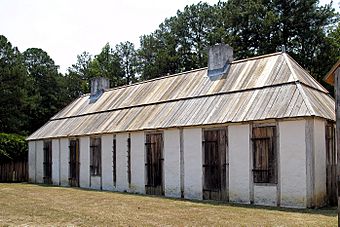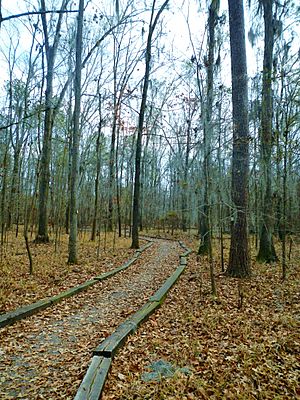Fort Toulouse facts for kids
|
Fort Toulouse Site-Fort Jackson
|
|

A portion of the modern Fort Toulouse reconstruction, photo taken in 2007
|
|
| Location | Elmore County, Alabama, USA |
|---|---|
| Nearest city | Wetumpka, Alabama |
| NRHP reference No. | 66000148 |
Quick facts for kids Significant dates |
|
| Added to NRHP | October 15, 1966 |
| Designated NHL | October 9, 1960 |
Fort Toulouse, also known as Fort des Alibamons, is a historic fort near the city of Wetumpka, Alabama, United States. Today, the Alabama Historical Commission takes care of it. The French built this fort in 1717. They named it after Louis-Alexandre de Bourbon, comte de Toulouse. France built the fort to protect its land in Louisiana. It also helped them stop the growing power of British colonies like Georgia and Carolina.
Contents
History of Fort Toulouse
Building the Fort and Making Friends
The fort was also called the "Post of the Alabama." This name came from the Alabama tribe. They were a group of Upper Creek Native Americans. They lived near where the Coosa and Tallapoosa rivers join. This area is close to the Alabama River.
About 20 to 50 French Colonial Marines lived and worked at the fort. They traded a lot with the local Creek Native Americans. They also built good relationships with them. The French traded European goods like guns, ammunition, and tools. They also traded knives, glass beads, copper pots, and wool blankets. In return, they received local foods, furs, and deerskins.
Around 1720, the French commander Captain Jean Baptiste Louis DeCourtel Marchand married a high-status Creek woman named Sehoy. Later, famous Creek chiefs like Alexander McGillivray and William Weatherford were her descendants. They inherited their leadership status from their mothers' families. This is called a matrilineal system.
Challenges and Changes at the Fort
Life at the fort was not always easy. The French government often neglected it. In 1722, the soldiers had a mutiny. They killed Captain Marchand and tied up the other officers. The soldiers then left the fort. But the captured officers escaped. With help from nearby Creek people, they caught the mutineers. The mutineers were sent to Fort Conde in Mobile for punishment.
By the early 1740s, conditions at the fort got better. Many soldiers married French women from Mobile. Others married local Creek women. These families and other settlers started many farms nearby. This helped improve the food supply for everyone.
The humid climate caused the fort to wear down by the late 1740s. So, the French planned to build a third fort. Captain Francois Saucier led the reconstruction of Fort Toulouse. It was finished around 1751. This new fort cost a lot of money for the Louisiana colony.
The French Leave and a New Fort Appears
In 1763, the Treaty of Paris ended the French and Indian War. France lost the war to the British. They had to give up their territory. So, the French soldiers at Fort Toulouse made their cannons unusable and left. They went to New Orleans and some eventually returned to France. The British decided not to use the fort. Over time, it fell apart. In 1776, a naturalist named William Bartram visited the area. He was studying the plants and animals.
During the War of 1812 and the Creek War, General Andrew Jackson brought his troops to the old Fort Toulouse site. He ordered a much larger fort to be built. General Joseph Graham named this new fort Fort Jackson. This was to honor Jackson's victories against the Creek and in the Battle of New Orleans.
Fort Toulouse-Fort Jackson State Historic Site
The U.S. Department of Interior named the site a National Historic Landmark in 1960. During the American Bicentennial celebrations, local groups helped rebuild Fort Toulouse. However, the replica was built on the outline of the larger Fort Jackson by mistake.
In the 1980s, the Alabama Historical Commission took over the park. They removed the incorrect replica. Then, they built a new replica of Fort Toulouse closer to its original spot. This allows for Fort Jackson to be rebuilt on its own site later. Archaeological digs are still happening at the site. Dr. Craig Sheldon from Auburn University at Montgomery supervises these digs.
The Fort Toulouse-Fort Jackson State Historic Site offers living history programs. These programs show what life was like for the Creek people, French colonists, and U.S. military troops during the War of 1812. The fort is southwest of Wetumpka, off U.S. Highway 231.
The site also has the Taskigi Mound. This is a prehistoric village from the South Appalachian Mississippian culture. It had a palisade (a fence of strong posts) and a central open area called a plaza. There was also a rectangular platform mound. This mound is part of the "Alabama Indigenous Mound Trail" from the University of Alabama Museums.




